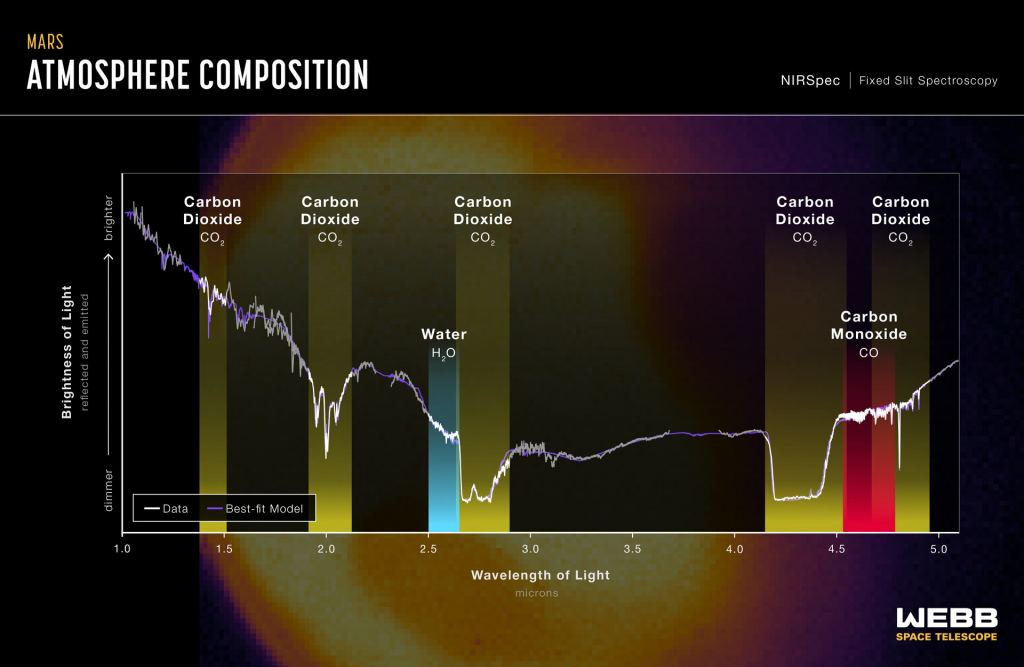Webb Turns its Infrared Gaze on Mars
By Matt Williams
The James Webb Space Telescope (JWST) is the most complex and sophisticated observatory ever deployed. Using its advanced suite of infrared instruments, coronographs, and spectrometers – contributed by NASA, the European Space Agency (ESA), and the Canadian Space Agency (CSA) – this observatory will spend the next ten to twenty years building on the achievements of its predecessor, the venerable Hubble. This includes exoplanet characterization, star and planet formation, and the formation and evolution of the earliest galaxies in the Universe.
However, one of the main objectives of the JWST is to study the planets, moons, asteroids, comets, and other celestial bodies here in the Solar System. This includes Mars, the first Solar planet to get the James Webb treatment! The images Webb took (recently released by the ESA) provide a unique perspective on Mars, showing what the planet looks like in infrared wavelengths. The data yielded by these images could provide new insight into Mars’ atmosphere and environment, complimenting decades of observations by orbiters, landers, rovers, and other telescopes.
These observations were part of Webb’s Cycle 1 Guaranteed Time Observation (GTO) Solar System program, led by Heidi Hammel – the Vice President for Science with the Association of Universities for Research in Astronomy (AURA). The images were taken by Webb‘s Near-Infrared Camera (NIRCam) and Mid-Infrared Instrument (MIRI) of Mars’ observable disk (the sunlit-facing side) and show a region of the planet’s eastern hemisphere in these two wavelengths. The telescope was positioned nearly 1.5 million km (932,000 mi) at the Sun-Earth L2 Lagrange Point, where it will remain for its entire mission.

This position and Webb‘s sophisticated instruments allow the telescope to capture images and spectra with the resolution needed to study Martian phenomena like seasonal changes, dust storms, weather patterns, and the planet’s daily cycles (day/night, sunrise, sunset). The image above shows a surface reference map from NASA and the Mars Orbiter Laser Altimeter (MOLA) on the left (with the two Webb NIRCam instrument views overlaid). The NIRCam near-infrared images are shown on the right and show where the solar reflection is greatest (the subsolar point) centered around Syrtis Major Planum.
The Mars images show differences in brightness integrated over many wavelengths from place to place across the planet on a particular day and time. Meanwhile, the spectra obtained show the subtle variations in brightness between hundreds of different wavelengths, representing the planet’s thermal properties as a whole. These spectroscopic observations are the first of many that astronomers will analyze to learn more about the surface and atmosphere of the planet and how they evolved over time.
Webb also obtained spectra from Mars’ atmosphere with its Near-Infrared Spectrograph (NIRSpec), which revealed a spectrum (see image below) dominated by reflected sunlight at shorter wavelengths (less than 2 microns) and thermal emission at longer wavelengths (2 to 5 microns). From this, the mission team detected the chemical signatures of carbon dioxide, carbon monoxide, and water vapor. They also obtained information about atmospheric dust and clouds and some surface features.
Capturing these images proved challenging, as Webb’s instruments are optimized to detect faint light from the most distant galaxies in the Universe, and Mars is one of the brightest images in the night sky (in visible light and infrared). Therefore, special techniques were required to prevent Webb’s detectors from becoming blinded, a phenomenon known as “detector saturation.” To compensate, the observation team took very short exposures to measure only some of the light that hit the detectors and developed special data techniques to analyze the light gathered.

These images and the first near-infrared spectrum of Mars demonstrate the power of the JWST to characterize exoplanet atmosphere via spectroscopy. In the future, the mission team will use Webb‘s imaging and spectroscopic data to explore regional differences across Mars and search for other chemical signatures. This includes methane, a potential biosignature, and hydrogen chloride, which was first detected in Mars’ atmosphere in 2018 as part of a Martian dust storm.
These findings will build on previous data from the multiple orbiters, landers, and rovers that have explored Mars in the past two decades, characterizing its climate, atmosphere, and surface environment. At present, there are eleven missions in operation around Mars, like the ESA’s Mars Express and ExoMars Trace Gas Orbiter (TGO), NASA’s 2001 Mars Odyssey, Mars Global Surveyor (MGS), Mars Reconnaissance Orbiter (MRO), MAVEN orbiter, and the Curiosity and Perseverance rover, India’s Mangalyaan-1 mission, the Emirate’s Mars Mission (aka. the Hope probe), and China’s Tianwen-1 lander and Zhurong rover.
In 2028, the ESA will send the Rosalind Franklin rover to Mars, while the ESA and the Japanese Aerospace Exploration Agency (JAXA) will send the Martian Moons eXploration (MMX) to Mars’ moon Phobos. Webb’s next-generation capabilities will allow scientists to reconstruct Mars’ environmental history and learn how the planet evolved from a warmer, wetter environment that may have supported life (and may still) to the extremely cold and desiccated environment we see there today.
Further Reading: ESA
The post Webb Turns its Infrared Gaze on Mars appeared first on Universe Today.

September 22, 2022 at 03:10AM
via Universe Today read more...

Post a Comment